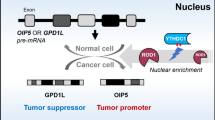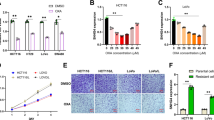Abstract
7SK small nuclear RNA (snRNA) is a 331–333-bp non-coding RNA, which recruits HEXIM 1/2 protein to inhibit positive elongation factor b (P-TEFb) activity. P-TEFb is an essential factor in alleviating promoter-proximal paused RNA polymerase II (Pol II) and initiating the productive elongation phase of gene transcription. Without this protein, Pol II will remain in its hypophosphorylated state, and no transcription occurs. In this study, we inhibited P-TEFb activity by over-expressing 7SK snRNA in human embryonic kidney (HEK) 293T cancer cell line. This inhibition led to a significant decrease in cell viability, which can be due to the transcription inhibition. Moreover, 7SK snRNA over-expression promoted apoptosis in cancerous cells. Our results suggest 7SK snRNA as a potential endogenous anti-cancer agent, and to the best of our knowledge, this is the first study that uses a long non-coding RNA’s over-expression against cancer cell growth and proliferation.





Similar content being viewed by others
References
Maher B. ENCODE: the human encyclopaedia. Nature. 2012;489(7414):46–8.
Lukovic D et al. Non-coding RNAs in pluripotency and neural differentiation of human pluripotent stem cells. Front Genet. 2014;5:132.
Petri R et al. miRNAs in brain development. Exp Cell Res. 2014;321(1):84–9.
Pagani M et al. Role of microRNAs and long-non-coding RNAs in CD4(+) T-cell differentiation. Immunol Rev. 2013;253(1):82–96.
Hu W, Alvarez-Dominguez JR, Lodish HF. Regulation of mammalian cell differentiation by long non-coding RNAs. EMBO Rep. 2012;13(11):971–83.
Clark BS, Blackshaw S. Long non-coding RNA-dependent transcriptional regulation in neuronal development and disease. Front Genet. 2014;5:164.
Shimoni Y et al. Regulation of gene expression by small non-coding RNAs: a quantitative view. Mol Syst Biol. 2007;3:138.
Rinn JL, Chang HY. Genome regulation by long noncoding RNAs. Annu Rev Biochem. 2012;81:145–66.
Bergmann JH, Spector DL. Long non-coding RNAs: modulators of nuclear structure and function. Curr Opin Cell Biol. 2014;26:10–8.
Gupta RA et al. Long non-coding RNA HOTAIR reprograms chromatin state to promote cancer metastasis. Nature. 2010;464(7291):1071–6.
Schickel R et al. MicroRNAs: key players in the immune system, differentiation, tumorigenesis and cell death. Oncogene. 2008;27(45):5959–74.
Yang BF, Lu YJ, Wang ZG. MicroRNAs and apoptosis: implications in the molecular therapy of human disease. Clin Exp Pharmacol Physiol. 2009;36(10):951–60.
Derrien T et al. The GENCODE v7 catalog of human long noncoding RNAs: analysis of their gene structure, evolution, and expression. Genome Res. 2012;22(9):1775–89.
Wang KC, Chang HY. Molecular mechanisms of long noncoding RNAs. Mol Cell. 2011;43(6):904–14.
Prensner JR, Chinnaiyan AM. The emergence of lncRNAs in cancer biology. Cancer Discov. 2011;1(5):391–407.
Tsai MC, Spitale RC, Chang HY. Long intergenic noncoding RNAs: new links in cancer progression. Cancer Res. 2011;71(1):3–7.
Gutschner T et al. The noncoding RNA MALAT1 is a critical regulator of the metastasis phenotype of lung cancer cells. Cancer Res. 2013;73(3):1180–9.
Yang G, Lu X, and Yuan L. LncRNA: a link between RNA and cancer. Biochim Biophys Acta. 2014.
Wassarman DA, Steitz JA. Structural analyses of the 7SK ribonucleoprotein (RNP), the most abundant human small RNP of unknown function. Mol Cell Biol. 1991;11(7):3432–45.
Krueger BJ et al. LARP7 is a stable component of the 7SK snRNP while P-TEFb, HEXIM1 and hnRNP A1 are reversibly associated. Nucleic Acids Res. 2008;36(7):2219–29.
Jeronimo C et al. Systematic analysis of the protein interaction network for the human transcription machinery reveals the identity of the 7SK capping enzyme. Mol Cell. 2007;27(2):262–74.
Nguyen VT et al. 7SK small nuclear RNA binds to and inhibits the activity of CDK9/cyclin T complexes. Nature. 2001;414(6861):322–5.
Yang Z et al. The 7SK small nuclear RNA inhibits the CDK9/cyclin T1 kinase to control transcription. Nature. 2001;414(6861):317–22.
Peterlin BM, Brogie JE, Price DH. 7SK snRNA: a noncoding RNA that plays a major role in regulating eukaryotic transcription. Wiley Interdiscip Rev RNA. 2012;3(1):92–103.
Peng J et al. Identification of multiple cyclin subunits of human P-TEFb. Genes Dev. 1998;12(5):755–62.
Li Q et al. Analysis of the large inactive P-TEFb complex indicates that it contains one 7SK molecule, a dimer of HEXIM1 or HEXIM2, and two P-TEFb molecules containing Cdk9 phosphorylated at threonine 186. J Biol Chem. 2005;280(31):28819–26.
Zhou Q, Li T, Price DH. RNA polymerase II elongation control. Annu Rev Biochem. 2012;81:119–43.
Moiola C et al. Cyclin T1 overexpression induces malignant transformation and tumor growth. Cell Cycle. 2010;9(15):3119–26.
Kota SK, Balasubramanian S. Cancer therapy via modulation of micro RNA levels: a promising future. Drug Discov Today. 2010;15(17–18):733–40.
Vitiello M, Tuccoli A, and Poliseno L. Long non-coding RNAs in cancer: implications for personalized therapy. Cell Oncol (Dordr). 2014.
Tripathi V et al. Long noncoding RNA MALAT1 controls cell cycle progression by regulating the expression of oncogenic transcription factor B-MYB. PLoS Genet. 2013;9(3):e1003368.
Huang J et al. Lentivirus-mediated RNA interference targeting the long noncoding RNA HOTAIR inhibits proliferation and invasion of endometrial carcinoma cells in vitro and in vivo. Int J Gynecol Cancer. 2014;24(4):635–42.
Cheng Y et al. LARP7 is a potential tumor suppressor gene in gastric cancer. Lab Invest. 2012;92(7):1013–9.
Ji X et al. LARP7 suppresses P-TEFb activity to inhibit breast cancer progression and metastasis. Elife. 2014;3:e02907.
Nielsen S, Yuzenkova Y, Zenkin N. Mechanism of eukaryotic RNA polymerase III transcription termination. Science. 2013;340(6140):1577–80.
Dong X et al. PlasMapper: a web server for drawing and auto-annotating plasmid maps. Nucleic Acids Res. 2004;32(Web Server issue):W660-4.
Pfeifer A et al. Delivery of the Cre recombinase by a self-deleting lentiviral vector: efficient gene targeting in vivo. Proc Natl Acad Sci U S A. 2001;98(20):11450–5.
Schmittgen TD, Livak KJ. Analyzing real-time PCR data by the comparative C(T) method. Nat Protoc. 2008;3(6):1101–8.
Pfaffl MW, Horgan GW, Dempfle L. Relative expression software tool (REST) for group-wise comparison and statistical analysis of relative expression results in real-time PCR. Nucleic Acids Res. 2002;30(9):e36.
Chao SH, Price DH. Flavopiridol inactivates P-TEFb and blocks most RNA polymerase II transcription in vivo. J Biol Chem. 2001;276(34):31793–9.
Lee Y et al. MicroRNA genes are transcribed by RNA polymerase II. EMBO J. 2004;23(20):4051–60.
Adelman K, Lis JT. Promoter-proximal pausing of RNA polymerase II: emerging roles in metazoans. Nat Rev Genet. 2012;13(10):720–31.
Smith E, Shilatifard A. Transcriptional elongation checkpoint control in development and disease. Genes Dev. 2013;27(10):1079–88.
Peterlin BM, Price DH. Controlling the elongation phase of transcription with P-TEFb. Mol Cell. 2006;23(3):297–305.
Yamada T et al. P-TEFb-mediated phosphorylation of hSpt5 C-terminal repeats is critical for processive transcription elongation. Mol Cell. 2006;21(2):227–37.
Guha M. Blockbuster dreams for Pfizer’s CDK inhibitor. Nat Biotechnol. 2013;31(3):187.
Hofmeister CC et al. A phase I trial of flavopiridol in relapsed multiple myeloma. Cancer Chemother Pharmacol. 2014;73(2):249–57.
Mizrahi A et al. Development of targeted therapy for ovarian cancer mediated by a plasmid expressing diphtheria toxin under the control of H19 regulatory sequences. J Transl Med. 2009;7:69.
Author information
Authors and Affiliations
Corresponding authors
Electronic supplementary material
Below is the link to the electronic supplementary material.
Figure S1
a. Gel electrophoresis image of 7SK snRNA cloned into pCDH-H1 vector, lanes from left to right are correspond to 1 kb ladder, undigested pCDH-7SK vector, pCDH-7SK digested with BamHI, and pCDH-7SK digested with BamHI and EcoRI. 330 bp band relates to cloned 7SK snRNA. b. Gel electrophoresis image of pCDH-H1 vector before cloning. (JPEG 154 kb)
Rights and permissions
About this article
Cite this article
Keramati, F., Seyedjafari, E., Fallah, P. et al. 7SK small nuclear RNA inhibits cancer cell proliferation through apoptosis induction. Tumor Biol. 36, 2809–2814 (2015). https://doi.org/10.1007/s13277-014-2907-8
Received:
Accepted:
Published:
Issue Date:
DOI: https://doi.org/10.1007/s13277-014-2907-8




